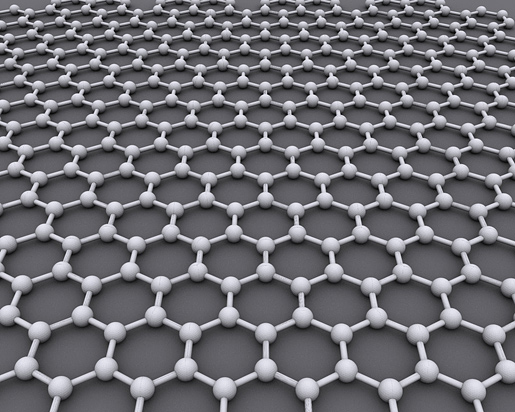2010 Nobel Prize in Physics
October 6, 2010
1905 is known as
Albert Einstein's Annus Mirabilis ("extraordinary year," from the Latin). In that year he published four significant papers in the German physics journal,
Annalen der Physik, as I discussed in a
previous article (The Anniversary of a Famous Equation, September 29, 2008).
• Photoelectric effect (vol.18, pp. 132-148). [1]
• Brownian motion, (vol.18, pp. 549-560). [2]
• Mass-energy equivalence (vol.18, pp. 639-641, the E= MC2 paper). [3]
• Special relativity, (vol.18, pp. 891-921). [4]
Einstein needed to wait sixteen years after this for the award of his
Nobel Prize in Physics, although he was so confident that he would receive it that he promised his wife,
Mileva Maric, the prize money in a 1919 divorce settlement. His 1921 Nobel Prize citation was "for his services to Theoretical Physics, and especially for his discovery of the law of the
photoelectric effect," and not for the controversial topic of relativity. Also, the photoelectric effect involved
quantum mechanics, which was a hot topic at the time.
Rudolf Mössbauer needed to wait just four years between his discovery of the
Mössbauer Effect and his 1961 Nobel Prize in Physics which he shared with
Robert Hofstadter.
Jack Kilby waited 42 years from his 1958 invention of the integrated circuit until 2000 for his Physics Prize.
Robert Noyce, who died in 1990, was co discoverer of the integrated circuit with Kilby, but the Nobel Prize is never awarded posthumously,
This year's Nobel Prize in Physics is another of those awarded quite soon after the discovery. The 2010 Physics Prize was awarded to
Andre Geim and
Konstantin Novoselov, both of the
University of Manchester, "for groundbreaking experiments regarding the two-dimensional material
graphene."[5-7] The pair will share the $1.5 million monetary award. Their first paper on graphene, the two-dimensional, single atom thickness form of
carbon, was published in 2004,[8] and since that time, graphene has revitalized
condensed matter physics.

Pictorial representation of a graphene sheet (Alexander Alus).
There must be a tradition in
England of doing simple experiments.
Ernest Rutherford's laboratory at
Cambridge revolutionized physics with experiments involving string and sealing wax. The Manchester group used
cellophane tape to peel off single layers of graphene carbon from bulk
graphite. Geim and Novoselov are both
Russian-born, although Geim is a
Dutch citizen, Novoselov has dual British and Russian citizenship, and both work at the University of Manchester in England.
Geim said in a
Stockholm press conference in which he participated via telephone, that he "didn't expect the Nobel Prize this year."[6] Of course, his prize for graphene was inevitable, and his statement appears to indicate that he, just like Einstein, realized he had the prize "
in the bag." There's no doubt that graphene is the current "wonder material." Its mechanical electrical and optical properties are unique, and its discovery has generated a flurry of research. A
Google Scholar search for "graphene" gives 50,000 hits. A standard
Google Search yields 8,750,000, with 1,690,000 in the past year.
It's interesting to note that in 2000 Geim was awarded an
Ig Nobel Physics Prize, along with
Michael Berry (famous for the
Berry Phase), for using a
magnetic field to
levitate a frog.[9]
References:
- Albert Einstein, "Über einen die Erzeugung und Verwandlung des Lichtes betreffenden heuristischen Gesichtspunkt,"Annalen der Physik, vol. 17, pp. 132-148 (1905).
- Albert Einstein, "Über die von der molekularkinetischen Theorie der Wärme geforderte Bewegung von in ruhenden Flüssigkeiten suspendierten Teilchen,"Annalen der Physik, vol. 17, pp. 549-560 (1905),
- Albert Einstein, "Ist die Trägheit eines Körpers von seinem Energieinhalt abhängig?,"Annalen der Physik, vol. 17, pp. 639-641 (1905).
- Albert Einstein, "Zur Elektrodynamik bewegter Körper,"Annalen der Physik, vol. 17, pp. 891-921 (1905).
- The Royal Swedish Academy of Sciences has decided to award the Nobel Prize in Physics for 2010 to Andre Geim, University of Manchester, UK, and Konstantin Novoselov, University of Manchester, UK, "for groundbreaking experiments regarding the two-dimensional material graphene," Nobel Prize Foundation Press Release, October 5, 2010.
- Naomi Kresge, "Russians Win Physics Nobel for Graphene Material," Bloomberg News, October 5, 2010.
- Materials breakthrough wins Nobel, BBC News, October 5, 2010.
- K. S. Novoselov, A. K. Geim, S. V. Morozov, D. Jiang, Y. Zhang, S. V. Dubonos, I. V. Grigorieva and A. A. Firsov, "Electric Field Effect in Atomically Thin Carbon Films," Science, vol. 306, no. 5696 (October 22, 2004), pp. 666-669.
- M.V. Berry and A.K. Geim, "Of Flying Frogs and Levitrons," European Journal of Physics, vol. 18, no. 4 (July, 1997), pp. 307-313.
Permanent Link to this article
Linked Keywords: Albert Einstein; Annus Mirabilis; Annalen der Physik; Photoelectric effect; Brownian motion; Mass-energy equivalence; Special relativity; Nobel Prize in Physics; Mileva Maric; photoelectric effect; quantum mechanics; Rudolf Mössbauer; Mössbauer Effect; Robert Hofstadter; Jack Kilby; Robert Noyce; Andre Geim; Konstantin Novoselov; University of Manchester; graphene; carbon; condensed matter physics; England; Ernest Rutherford; Cambridge; cellophane; graphite; Russian; Dutch; Stockholm; in the bag; Google Scholar;Google Search; Ig Nobel Physics Prize; Michael Berry; Berry Phase; magnetic field; levitate a frog.